1. Early Life and Amateur Career
Johan Museeuw's early life and amateur career were significantly shaped by his family's involvement in cycling and his geographical roots in West Flanders.
1.1. Birth and Family
Museeuw was born in Varsenare and grew up in Gistel, both located in West Flanders, Belgium. His father, Eddy Museeuw, was also a professional cyclist, although his career was brief, lasting only two years. This family background provided an early introduction to the sport for Johan.
1.2. Amateur Career
During his junior and amateur years, Museeuw engaged in cyclo-cross racing during the winter months, complementing his road cycling activities. He achieved several minor successes as a junior and amateur on the road, laying the groundwork for his eventual professional career.
2. Professional Career
Museeuw's professional cycling career saw him evolve from a promising sprinter into one of the most formidable classics specialists of his generation, marked by significant team changes, triumphs, and a remarkable comeback from severe injuries.
2.1. Early Years (1988-1989)
Johan Museeuw began his professional journey in 1988 with the ADR cycling team. In 1989, he played a crucial support role for his team leader, Greg LeMond, during the 1989 Tour de France, where LeMond secured his second overall victory. Museeuw was often seen at the front of the peloton, setting the pace for days while LeMond wore the yellow jersey.
2.2. Sprinter Phase (1990-1992)
In 1990, Museeuw joined the Lotto team. During this period, he demonstrated his capabilities as a sprinter, winning two stages in the 1990 Tour de France. These victories included an uphill sprint stage to Mont Saint-Michel and the final stage in Paris, both achieved in mass sprints. However, in an era increasingly dominated by successful breakaways, he found it challenging to secure further individual stage victories despite winning numerous peloton sprints behind escape groups.
In 1991, Museeuw secured multiple stage wins in smaller stage races. In August of that year, he claimed his first victory in a World Cup race, the Championship of Zürich. The 1992 season saw him finish third in Milan-San Remo, winning the peloton sprint behind Sean Kelly and Moreno Argentin. He also achieved his first victory in a cobbled semi-classic, E3 Harelbeke, and won the Belgian national road race title in Peer. He finished second in the points classification of the 1992 Tour de France for the second time, behind Laurent Jalabert.
2.3. Transition to Classics Specialist (1993-1994)
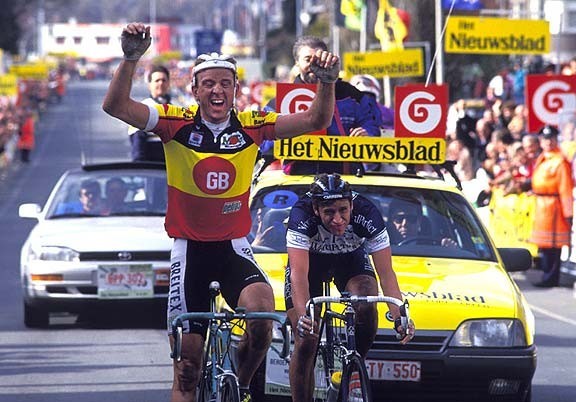
In 1993, Museeuw transferred to the MG-GB team, where he developed a significant professional relationship with manager Patrick Lefevere. Under Lefevere's guidance, Museeuw transformed from a sprinter into a dedicated classics specialist. This involved shifting his powerful sprint focus towards developing greater endurance and stamina, which was essential for competing in the demanding spring classics, particularly the cobbled classics such as Paris-Roubaix and the Tour of Flanders. His 1993 spring campaign was strong, featuring a stage win in Paris-Nice and a victory in Dwars door Vlaanderen. He subsequently started the Tour of Flanders as a favorite and won it in a two-man sprint against Frans Maassen, marking his first triumph in a monument classic. In the 1993 Tour de France, he wore the yellow jersey for two days after strong performances in the prologue and team time trial, and he again finished second in the final points classification. Later in 1993, he won Paris-Tours, securing his third World Cup victory.
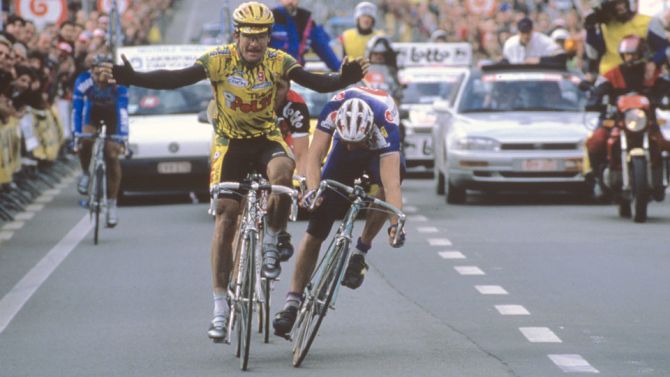
The 1994 season saw Museeuw win Kuurne-Brussels-Kuurne and consistently contend in all cobbled classics. However, he was unable to secure a victory in any of the major ones. He narrowly missed his second Tour of Flanders win, being beaten by Gianni Bugno in a sprint by a mere 0.3 in (7 mm). A week later, in Paris-Roubaix, while furiously pursuing Andrei Tchmil, he suffered a mechanical failure on the cobblestones, ultimately finishing 13th. He concluded his spring campaign with a victory in the Amstel Gold Race after a two-man sprint with Bruno Cenghialta, earning his fourth World Cup win. In the Tour de France, he again wore the yellow jersey for three days before losing it to Miguel Induráin in a long time trial. He finished the year ranked sixth in the UCI Road World Rankings.
2.4. Peak Years: World Cup and World Champion (1995-1997)
In 1995, Museeuw's MG-GB team merged with Mapei-Clas, forming the formidable Italian-Belgian Mapei squad that dominated cycling's classic races throughout the 1990s. He won the Tour of Flanders that year, a victory that cemented his nickname The Lion of Flanders in the Flemish media. He also won the Championship of Zürich and the overall standings of the 1995 World Cup, solidifying his reputation as the premier one-day classic rider of the year.
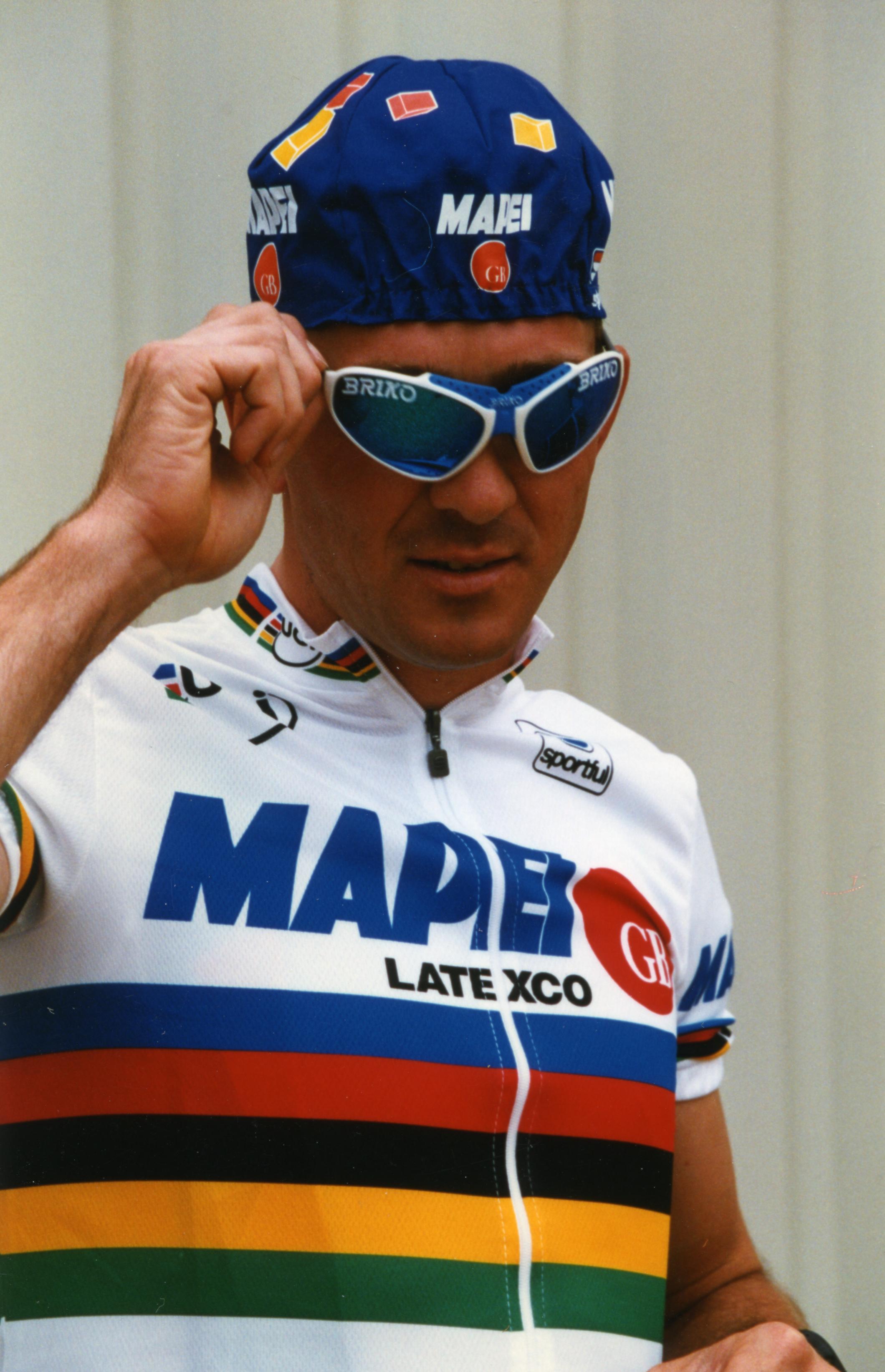
The 1996 season was exceptional for Museeuw. He won the Brabantse Pijl but placed third in the Tour of Flanders due to a mechanical failure. The following week, he finally claimed his first victory in Paris-Roubaix. The Mapei-GB team orchestrated a dominant performance, with Museeuw arriving at the Roubaix Velodrome alongside his Italian teammates Gianluca Bortolami and Andrea Tafi. Team manager Patrick Lefevere received direct orders from Mapei's managing director, Giorgio Squinzi, to ensure Museeuw won the race, leading to a controlled finish for the team. In the summer, he secured his second Belgian national road race title. Despite expressing intentions to quit cycling after a disappointing performance in Paris-Tours, he changed his mind and competed in the world championship road race. Despite a mountainous course in Lugano that did not favor him, Museeuw, on his 31st birthday, became world champion after a long breakaway, out-sprinting Mauro Gianetti. He then went on to win his second consecutive World Cup final standing.
In 1997, Museeuw started the year strongly with three stage wins in the Ruta del Sol and a victory in Kuurne-Brussels-Kuurne. However, a crash in Milan-San Remo, another in the Tour of Flanders, and a puncture in Paris-Roubaix prevented him from securing another World Cup win that season. He finished sixth in Liège-Bastogne-Liège, his best result in that Ardennes classic. While wearing the rainbow jersey, he abandoned the 18th stage of the Tour de France after several unsuccessful attempts to win a stage from a breakaway. He attempted to defend his world title in San Sebastián but missed the decisive breakaway, finishing eighth.
2.5. Injury and Comeback (1998-2000)
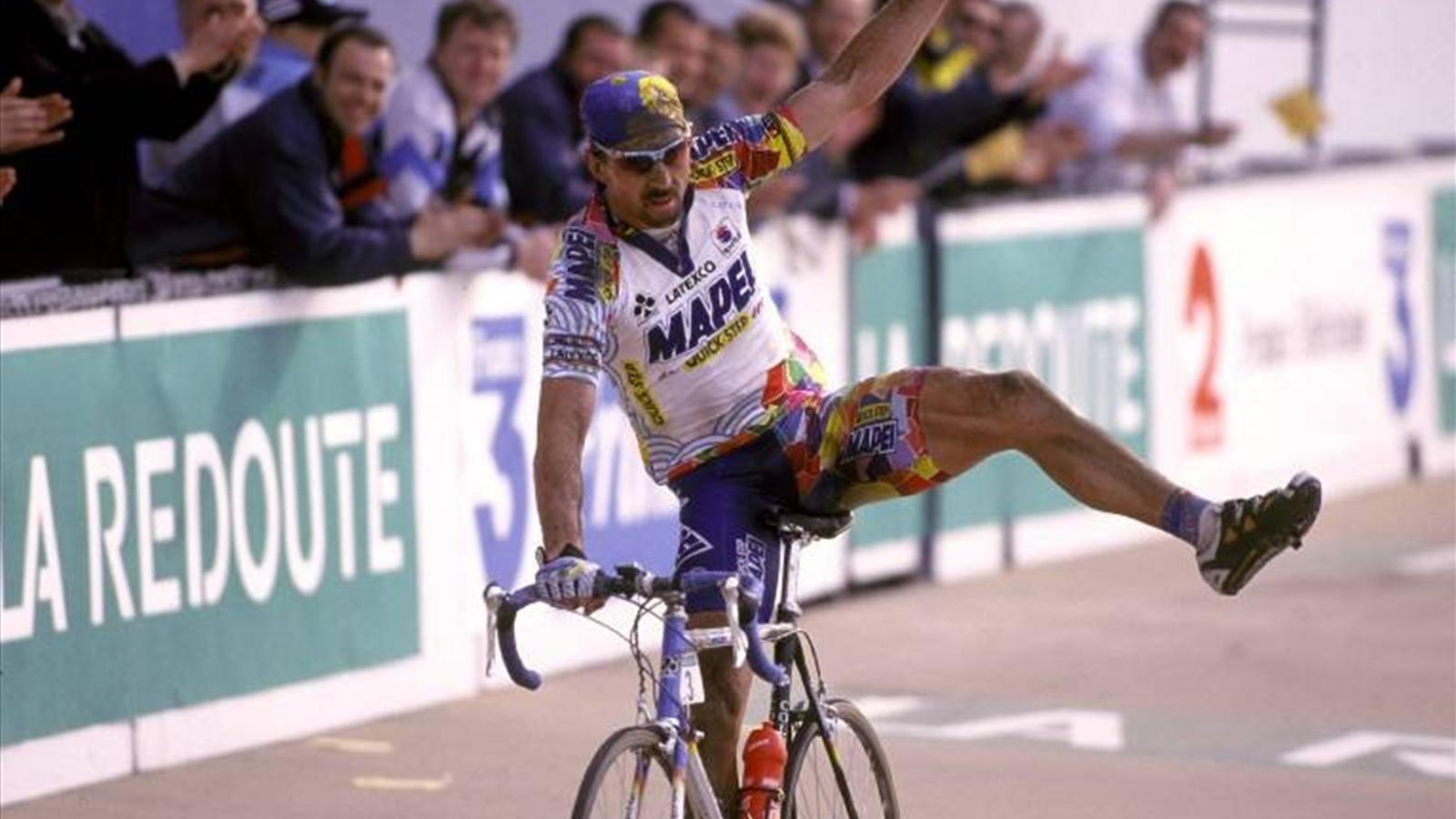
The year 1998 saw Museeuw achieve remarkable success before suffering a career-threatening injury. One week after winning both E3 Harelbeke and the Brabantse Pijl on the same weekend, he won the Tour of Flanders, matching the race record of three victories with a powerful solo performance. Just a week later, during Paris-Roubaix, he suffered a horrific fall on the notorious Trouée d'Arenberg cobbled sector, which resulted in a shattered kneecap. Compounding the injury, he developed a dangerous gangrene infection that nearly necessitated the amputation of his left leg.
Despite the severity of his injuries, Museeuw displayed immense determination. After a prolonged healing process, he returned to competitive cycling, impressively finishing third in the Tour of Flanders and ninth in Paris-Roubaix, exactly one year after his devastating crash. In 2000, he achieved a remarkable comeback victory, winning Paris-Roubaix for the second time after a solo effort of 27 mile (44 km). Upon crossing the finish line, he famously lifted his left leg and pointed to his knee, a powerful gesture symbolizing his triumph over the injury that had nearly ended his career. Later that year, Museeuw suffered another serious setback when he was severely injured in a motorcycle accident while riding with his wife and son. He sustained severe head trauma and spent several days in a coma. While all three recovered, Museeuw's unwavering determination again propelled him back to the pinnacle of the sport. His powerful riding style garnered him a vast fanbase worldwide and significantly enhanced his popularity in his native Flanders.
2.6. Later Career and Return to Form (2001-2002)
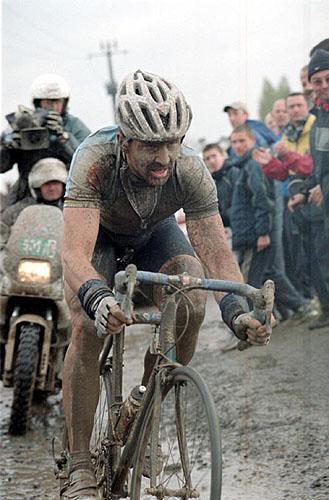
In 2001, Museeuw moved to the Domo-Farm Frites team, once again under the management of Patrick Lefevere, to continue his comeback after his second major accident. He achieved a second-place finish in Paris-Roubaix and a fifth-place in the Amstel Gold Race. He also participated in the Tour de France for the last time but abandoned during the Pyrenees stages.
By 2002, Museeuw had fully regained his top form. He secured a second-place finish in the Tour of Flanders and a dominant third victory in Paris-Roubaix. His win in the "Hell classic" marked his tenth victory in a World Cup race, showcasing overwhelming power even as younger rivals like George Hincapie and Tom Boonen attempted to pursue him. Later that year, he won the HEW Cyclassics in Hamburg, bringing his total World Cup wins to eleven.
2.7. Final Years and Retirement (2003-2004)
In 2003, Museeuw followed Patrick Lefevere to the newly established Quick Step team. He won the Omloop Het Volk early in the season, but an illness hampered his preparation for the spring classics. Towards the end of his illustrious career, Museeuw took on a mentoring role for his young teammate Tom Boonen, who was widely considered his successor as a leading figure in the cobbled classics. In his final seasons, he attempted to set a new record by winning the Tour of Flanders or Paris-Roubaix for a fourth time, but he was unsuccessful. However, with a combined six victories in the Tour of Flanders and Paris-Roubaix, he held the record for combined wins in these two races until Boonen surpassed it in 2012.
Museeuw concluded his 17-year professional career in the spring of 2004, having amassed 59 professional victories. In his final classic race, the 2004 Paris-Roubaix, he suffered an unfortunate puncture just 3.1 mile (5 km) before the finish while riding in the leading breakaway, which dashed his last opportunity to equal Roger De Vlaeminck's record. He finished fifth, in tears, alongside his long-time rival Peter Van Petegem. Museeuw's very last race was three days later, the Scheldeprijs in Belgium on 14 April 2004, which was won by his protégé, Tom Boonen. A farewell race was organized in his hometown of Gistel on 2 May. Following his retirement, Museeuw assumed a non-riding position with the Quick Step team. He has since donated many of his trophies to museums, including the Centrum Ronde van Vlaanderen, but notably retains three trophies from his victories in the Tour of Flanders, Paris-Roubaix, and the World Championship.
3. Career Achievements
Johan Museeuw's professional cycling career was marked by an extensive list of victories and accolades, particularly distinguishing him as a leading classics rider of his era.
3.1. Key Victories
Museeuw's most significant victories include:
- Road Race World Champion: 1996
- Tour of Flanders: 1993, 1995, 1998
- Paris-Roubaix: 1996, 2000, 2002
- UCI Road World Cup: 1995, 1996 (Overall Classification)
- Belgian National Road Race Championships: 1992, 1996
- Championship of Zürich: 1991, 1995
- Amstel Gold Race: 1994
- Paris-Tours: 1993
- HEW Cyclassics: 2002
3.2. Monument Results
Museeuw consistently performed in cycling's most prestigious one-day races, known as the monuments:
| Monument | 1989 | 1990 | 1991 | 1992 | 1993 | 1994 | 1995 | 1996 | 1997 | 1998 | 1999 | 2000 | 2001 | 2002 | 2003 | 2004 |
|---|---|---|---|---|---|---|---|---|---|---|---|---|---|---|---|---|
| Milan-San Remo | - | 9 | - | 3 | 32 | 12 | 40 | 8 | 40 | 36 | - | 15 | 80 | - | - | - |
| Tour of Flanders | 62 | - | 2 | 14 | 1 | 2 | 1 | 3 | 13 | 1 | 3 | 33 | 16 | 2 | 38 | 15 |
| Paris-Roubaix | - | 12 | 16 | 7 | 4 | 13 | 3 | 1 | 3 | DNF | 9 | 1 | 2 | 1 | 33 | 5 |
| Liège-Bastogne-Liège | - | - | - | 36 | 12 | 58 | 13 | - | 6 | - | - | 90 | DNF | DNF | - | - |
| Giro di Lombardia | - | - | - | - | - | - | - | 13 | - | - | - | - | - | - | - | - |
| - | Did not compete |
|---|---|
| DNF | Did not finish |
3.3. Other Notable Wins
- 1988: GP Briek Schotte
- 1989: Criterium Oostende, Criterium Deerlijk, GP Impanis-Van Petegem (2nd), Grand Prix d'Isbergues (2nd), Tour of Belgium Stage 5, Paris-Tours (3rd)
- 1990: Criterium Aalst, Criterium Dilsen, Criterium Valkenswaard, Criterium Lichtervelde, Tour de France Stages 4 & 21, Grand Prix de Plumelec-Morbihan, Three Days of De Panne Stage 3b, Four Days of Dunkirk Stage 1, Tour de l'Oise Stage 1, Nissan Classic Stage 3, Gent-Wevelgem (2nd), Scheldeprijs (3rd), Milan-San Remo (9th), Amstel Gold Race (9th)
- 1991: Criterium De Haan, Criterium Deerlijk, Criterium Bavikhove, Kampioenschap van Vlaanderen, Vuelta a Andalucía Stages 2 & 5, Midi Libre Stage 3b, Tour of Britain Stage 2, Tour of Flanders (2nd), Rund um den Henninger-Turm (2nd), Four Days of Dunkirk Stage 4, Nissan Classic Stage 3, Paris-Brussels (3rd), UCI Road World Rankings (5th), Paris-Tours (9th), Vuelta a Aragón (10th), Amstel Gold Race (10th)
- 1992: Criterium Bellegem, Criterium Peer, Belgian National Road Race Championships Road race, E3 Prijs Vlaanderen, Volta a la Comunitat Valenciana Stages 1 & 2, Vuelta a Andalucía Stage 5, Bicicleta Vasca Stage 1, Vuelta a Asturias Stage 1b, Tre Valli Varesine Stage 2, Amstel Gold Race (2nd), Scheldeprijs (2nd), Grote Prijs Jef Scherens (2nd), Circuito de Getxo (2nd), Milan-San Remo (3rd), Kuurne-Brussels-Kuurne (3rd), UCI Road World Rankings (7th), Paris-Roubaix (7th), UCI Road World Cup (8th)
- 1993: GP Wielerrevue, Criterium Hengeloo, Criterium Bavikhove, Dwars door België, Tour de France Stage 4 (TTT), Tour de Suisse Stage 1, Paris-Nice Stage 4, Hofbrau Cup Stage 4, UCI Road World Cup (2nd), Le Samyn (2nd), Paris-Brussels (3rd), Paris-Roubaix (4th), UCI Road World Rankings (6th), Wincanton Classic (8th)
- 1994: Criterium Made, Wielsbeke, Geraardsbergen, Druivenkoers Overijse, Tour de France Stage 3 (TTT), Tour de Suisse Stage 8, Tour Méditerranéen Stage 1a, Teleport Derny Amsterdam, UCI Road World Cup (2nd), Tour of Flanders (2nd), Züri-Metzgete (2nd), Binche-Chimay-Binche (2nd), GP Impanis-Van Petegem (2nd), Gent-Wevelgem (3rd), UCI Road World Rankings (6th)
- 1995: Criterium Bavikhove, Criterium Graz, Overall Four Days of Dunkirk (Stage 4), Omloop de Vlaamse Ardennen, Trofeo Laigueglia, Druivenkoers Overijse, Grand Prix Eddy Merckx, Kampioenschap van Vlaanderen, Paris-Roubaix (3rd), Clásica de San Sebastián (3rd), Belgian National Road Race Championships Road race (3rd), UCI Road World Rankings (4th), Leeds Classic (5th), Amstel Gold Race (7th), Rund um den Henninger-Turm (8th)
- 1996: Omloop Mandel-Leie-Schelde, Giro di Puglia Stage 1, Paris-Brussels (2nd), Tour of Flanders (3rd), Amstel Gold Race (3rd), Leeds Classic (3rd), Züri-Metzgete (3rd), UCI Road World Rankings (4th), Grand Prix des Nations (6th), Milan-San Remo (8th), Road race (Olympic Games) (10th)
- 1997: Criterium Peer, Criterium Kortrijk, Criterium Karlsruhe, Gala Tour de France, Overall Four Days of Dunkirk (Stage 3b (ITT)), Overall Three Days of De Panne, LuK Challenge Chrono (with Oskar Camenzind), Overall Vuelta a Andalucía (2nd) (Stages 2, 4 & 5), Belgian National Time Trial Championships Time trial (2nd), Scheldeprijs (2nd), Paris-Roubaix (3rd), Liège-Bastogne-Liège (6th), Grand Prix des Nations (7th), UCI Road World Rankings (9th)
- 1998: E3 Harelbeke, Brabantse Pijl
- 1999: Criterium Bavikhove, GP Briek Schotte, Dwars door België, Omloop Mandel-Leie-Schelde, Kuurne-Brussels-Kuurne (2nd), HEW Cyclassics (4th), UCI Road World Cup (6th), Paris-Roubaix (9th)
- 2000: Omloop Het Nieuwsblad, Brabantse Pijl, Gent-Wevelgem (3rd)
- 2001: Dernycriterium Wilrijk, Paris-Roubaix (2nd), Amstel Gold Race (5th), UCI Road World Cup (9th)
- 2002: Profronde van Made, Tour de Wallonie Stage 3, Tour of Flanders (2nd), E3 Harelbeke (3rd), Overall Guldensporentweedaagse (4th) (Stage 2), Classic Haribo (5th), Druivenkoers Overijse (7th), Dwars door Vlaanderen (9th), Gent-Wevelgem (10th)
- 2003: Omloop Het Nieuwsblad, Danmark Rundt Stage 3, Memorial Rik Van Steenbergen (3rd), Gent-Wevelgem (7th)
- 2004: Afscheidscriterium Johan Museeuw, Paris-Roubaix (5th)
3.4. Honours and Awards
Museeuw received numerous awards and distinctions recognizing his achievements and contributions to cycling:
- Crystal Bicycle Best Professional Cyclist: 1993, 1995, 1996, 1997, 2002
- Vlaamse Reus: 1995
- Sprint d'Or: 1995, 1996, 1997, 2002
- Belgian National Sports Merit Award: 1996
- Vélo d'Or Mondial: 1996
- Mendrisio d'Or: 1996
- Bici al Chiodo Award: 1996
- Honorary Citizen of Jabbeke: 1996
- Officer in the Belgian Order of Leopold: 2004
- Johan Museeuw Classics: From 2018 (a cycling event named in his honor)
4. Doping and Controversy
Johan Museeuw's career, like many of his generation, was affected by doping allegations and subsequent confessions, raising critical questions about the ethical implications for the sport's integrity.
4.1. Doping Allegations and Confession
In 2003, doping allegations surfaced implicating Museeuw. Press reports suggested his use of human growth hormone, allegedly obtained from veterinarian José Landuyt. Police authorities claimed that Museeuw had purchased banned substances in 2003, with recorded phone conversations between him and Landuyt using the codeword "wasps" to refer to Aranesp, a synthetic hormone known to increase red blood cell levels. Despite the absence of direct evidence, a ruling in 2004 determined there was sufficient reason for his athletic suspension for two years and referral to the criminal court.
On 24 January 2007, Museeuw publicly confessed to the charges at a press conference. He revealed that he had "not been completely honest in his last year as a professional, as he wanted to end his career in style," and simultaneously announced his resignation from his Quick Step team. In December 2008, a Belgian court convicted Museeuw for doping offenses alongside former cyclists Jo Planckaert and Chris Peers, who were involved in the same case. Museeuw received a 10-month suspended sentence, a fine of 2.50 K EUR, and further legal proceedings.
4.2. Reflections on Doping
In September 2012, Museeuw gave an interview to the Flemish newspaper Gazet van Antwerpen, where he candidly stated that "nearly every rider of his generation doped," implicitly acknowledging the broader extent of doping during his racing career. This statement provided a significant insight into the historical challenges and prevalence of doping within the sport. He also expressed his conviction that the current generation of cyclists represents "the cleanest cycling has ever seen." However, in 2018, he voiced concerns that while he was comfortable discussing past doping offenses, continued emphasis on the topic might prevent the new generation from demonstrating their distinct approach to the sport, potentially overshadowing their efforts to be clean.
5. Personal Life and Character
Beyond his athletic prowess, Johan Museeuw's personal life and character offered a contrast to the flamboyant personalities often seen in professional cycling.
5.1. Personality and Background
In contrast to more outspoken and flamboyant riders such as Mario Cipollini, Museeuw was known for his quiet and frugal personality, typical of a Flemish individual. He rarely publicly refuted criticisms from the media regarding his race performances. While many top cyclists drove luxury sports cars, Museeuw preferred ordinary passenger vehicles purchased from his father's Peugeot dealership. His family background was deeply rooted in cycling, with his father, Eddy Museeuw, also having been a professional road racer, albeit for a brief period of two years. This familial connection drew comparisons to other father-son cycling duos, such as Eddy Merckx and Axel Merckx.
5.2. Anecdotes and Episodes
Museeuw's career was marked by several notable incidents and a resilient spirit in the face of severe physical setbacks. He endured multiple serious injuries that threatened not only his professional career but also his daily life. In 1992, he suffered a complex fracture of his femur during a mass crash at a World Championship training camp. In 1998, he sustained a complex fracture of his patella (kneecap) during his dramatic fall in Paris-Roubaix. Beyond racing incidents, he also experienced a severe head injury involving a skull fracture from a motorcycle accident.
A significant episode occurred during the 1996 Paris-Roubaix, where his Mapei team dominated the race, achieving a historic 1-2-3 finish. The team's pre-arranged order of finish, rather than an all-out sprint for victory, drew some criticism from those who believed the riders should have competed fiercely. However, his teammate Gianluca Bortolami, who finished second, commented that the outcome would have been the same regardless, indicating Museeuw's superior strength that day.
Despite their contrasting personalities, Museeuw shared several commonalities with Italian sprinter Mario Cipollini: both were prominent sprinters in their early careers, came from families with cycling backgrounds, and were regarded as superstars in their respective countries. During his time with GB-MG, Museeuw often served as an assistant to Cipollini in Grand Tours. Throughout his career, Museeuw benefited from a strong contingent of capable assistants, notably his compatriot Wilfried Peeters, who consistently supported him. Other valuable teammates included Marco Saligari, Gianluca Bortolami, and Andrea Tafi, all of whom were successful riders in their own right and played crucial roles in Museeuw's major victories.